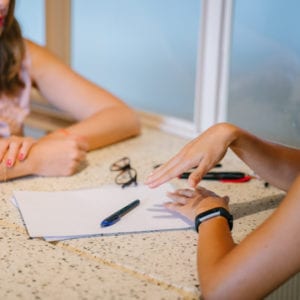3 tips for maintaining rigor in remote hands-on courses
Best practices to scale career awareness and exposure
While the transition to distance learning poses challenges for all educators, teachers of hands-on courses are tasked with a particularly difficult order. The learning that typically occurs in science labs, music rooms, art studios, and gymnasiums isn’t as easily transferable to a digital interface. Students don’t have equitable access to special materials, and teachers can’t accurately assess complex hands-on objectives.
Nevertheless, skills-based learning is a growing imperative for college and career readiness, and teachers are striving to maintain quality instruction in hands-on courses. Below are several suggestions to preserve academic and creative rigor in remote classes throughout the distance learning initiative.
Integrate lessons that build students’ foundational knowledge about hands-on skills

When redesigning the complexity of hands-on lessons, focus the central action of learning objectives on building students’ knowledge and understanding of foundational skills (the first two levels of Bloom’s Taxonomy) to further segment a complex hands-on skill. Focusing on this introductory knowledge not only translates more fluidly to virtual instruction and independent learning, but it also reduces the need for intricate materials and assessment. For example, when an art lesson objective asks a student to design a ceramic piece, students should have basic knowledge about clay and the ceramic process before completing the goal. The student must first be able to recognize the properties of clay, predict how a design might change in a hot kiln, and sketch a proportional design on paper. These foundational skills are the building blocks for the central learning objective and can still be implemented in a home learning environment.
To further define how each of the foundational tasks comprise the overarching objective, engage students in the “Parts, Purposes, and Complexities” thinking routine, as outlined by Harvard’s Project Zero. This thinking process can help students visualize the different components of a particular hands-on skill and provide important opportunities to scaffold instruction.
Ask students to choose assignments that are conducive to their home environments
In reality, some students may not have the necessary materials or equipment to complete a capstone hands-on assignment. To compensate for variability in students’ home environments, hands-on course educators should give students multiple assignment options that relate to the central learning objective or assessment. These activities should be simple to implement, requiring minimal resources and supervision so that students have the freedom to choose multiple methods of demonstrating their knowledge.
Choice boards are a great way to promote student choice because they are flexible in time or material constraints and consist of simple, easily understood assignments. This method of assigning tasks using a grid of options provides numerous opportunities for students to demonstrate a lesson objective or culminating skill. Give students an extended period of time (i.e., one week) to complete one or several options, ensuring that objectives can be met through any combination of the assignments listed. Use the sample choice board below as a model for aligning optional assignments to a central learning objective.
6th Grade Science Choice Board (abbreviated)
Students will compare and contrast work and energy
Complete 2 of the below tasks before April 24
Watch the simulation of work and energy linked below, and respond to the final question.
Read the article “Work” and answer questions 1-4.
Illustrate a cartoon showing someone doing work. Describe the scene below your illustrations.
Demonstrate work vs. energy in a FlipGrid video using your choice of materials.
Make flashcards for key vocabulary from the Work & Energy chapter.
Play the work & energy review game posted on Classroom with a family member.
Incorporate guest speakers and demonstrators in hands-on classes by tapping into the professional network of school staff

Without traditional classroom resources, many teachers of hands-on courses have difficulty finding materials and space for quality visual demonstrations as part of maintaining rigor in remote classes. Teachers can mitigate this challenge by sourcing industry professionals from the network of other district staff. A version of this practice is profiled as a method for virtual work-based learning in practice 7 of EAB’s Meeting the Career Readiness Imperative study.
To source volunteers, school staff members submit at least five professional contacts from their network (e.g., friends, family members, and previous employers) that might be relevant to the desired demonstration. Teachers then reach out to this network of professionals to source volunteers for skills-based partnerships. These industry volunteers not only are more likely to have necessary materials on-hand to perform effective presentations, but also can exemplify real-world utilization of targeted skills.
While circumstances surrounding distance learning are changing daily, it’s imperative to remember that hands-on learning is not being permanently replaced by lower-level skill review.
Alternatively, this pause in face-to-face instruction allows teachers to develop students’ foundational skills before returning to the workshop, focusing on building knowledge necessary to create, perform, and build in a hands-on field.
More Blogs

2 areas of growth for independent schools amid COVID-19 recovery

5 types of questions to ask families to improve the virtual learning experience
